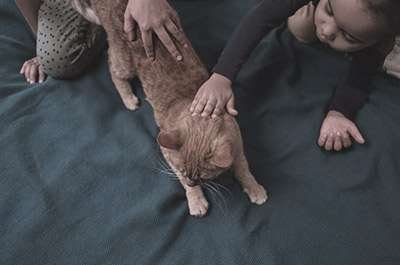Children can be apprehensive when a new pet is brought into the home. They may not understand why the family has decided to bring in another animal, and they may worry that they will lose attention from their parents. Here are a few tips to help children adjust to a new pet.
Introduce the pet to your children in a positive way.

When you bring a new pet into the house, it is best to introduce your children to them positively. This will help your children feel more comfortable when the pet is around.
It can often be helpful to bring your kids to a local pet store and let them pick out their toys and treats to bring home. Kids can feel more connected to the new pet when they are involved in the selection process.
Make sure they know what is going on with the new animal and its name so that they can get excited about the idea of a new animal in the house.
Tell your children that they can learn more about the new animal and ask them to look for signs of why you decided to bring it into the house. This will allow them to feel a sense of control and learn more about their new pet.
Encourage your children’s input.
Once the pet has made its way into your home, encourage your children to take part in caring for it. This will allow them to feel valued and will give them a sense of responsibility. It is crucial that they feel like their new pet is truly a family member and not just something you brought home.
Encourage your children to learn more about what the pet needs to be happy and healthy. If they are responsible for taking care of the pet, they might be more inclined to do it.
Children may be hesitant to interact with the new pet. They may want to ask questions about it or see if they can get a better idea of what it is like. Allow them to ask the new pet questions and get involved with the animal in any way they see fit.
Your children will also be able to give you valuable advice about the pet. They will know how it acts and its personality, which can help you make future decisions about caring for the new animal.
Help them understand how to behave around the pet.
Children may become overwhelmed when a new pet enters the home. If a child is acting out or misbehaving, it may be because they are stressed about the new animal. Help your children understand how to behave around the pet so that they can feel more comfortable and relaxed when it is around.
If your children are not sure how to act around the pet, it is helpful to tell them what they should do and shouldn’t do around the pet. For example, they should not hit or attempt to ride the animal, and they should be sure not to scare them.
Give your children some tasks that they can do to help with the new pet.
Your children must be able to care for the pet to feel a sense of responsibility and become well-rounded individuals. Let your children help out with some tasks, such as feeding the pet and cleaning up afterward.
If your children notice something wrong with the new animal, they should come to you right away. They must understand what to do in certain situations so that the new pet can remain comfortable and healthy throughout its stay in your home.
If your children are having difficulty adjusting to the new pet, talk with them about it. They may be feeling overwhelmed and insecure in their own homes. It is okay for your children to feel sad or angry that you brought a new pet into the house, but they must keep their emotions in check.
With the right amount of support, your children will soon adjust to having a new pet in the house.
Meet your children’s needs and wants.

When you bring a new pet into the home, it is important not to forget about your children. Children can be taken care of in many different ways.
If your children are afraid or nervous about the new pet, it is vital to show them that it will not harm them. You can establish a schedule and encourage your children to become involved with caring for the new animal, which will help them get used to the new pet’s presence.
If you are bringing a cat into your home, then one way for your children to bond with the cat is through play. For older children, you can set them up with some toys that will allow them to interact with the cat.
If your children are younger, you can allow them to play near the animal. They may want to pet it or play in the same area. Let them spend time near their new pet, but always supervise when they are playing.
If your children are excited about the new pet, there are several ways to take advantage of this. For instance, you could encourage your children’s input by making them a part of the decision-making process. You can have them help pick out a name for the pet or give their input on how to care for the animal.
Create a schedule.
When you bring a new pet into the home, it is important to establish routines. If you make your children part of this process and allow them to participate, they will feel more comfortable.
If your children are going to take care of the animal, they need to have a schedule. For instance, if they are in charge of feeding the pet in the morning, you should ensure that it is done at a specific time every day. If your children will brush the pet, make sure they do it regularly and regularly.
Creating a schedule is not only beneficial for the pet, but it can also help your children feel more involved in caring for an animal. Children tend to respond well to a schedule and a sense of organization.
If your children will have responsibility for the new pet, it is important that you set them up for success. If they know that certain tasks need to be done and that they will receive a reward or recognition, they will feel more inclined to participate.
Focus on your children.
Remember that when a new pet is brought into the home, it will be a big adjustment for your children as well.
Sometimes, your children will have strong reactions. They may become nervous or anxious around the new animal. They may even be angry or upset because you did not ask them about bringing it into the home.
When your children are struggling, it is essential to give them your full attention. If they are nervous, you can hold them and reassure them that the new pet will not harm them. If they are angry or sad about the new animal, then you can listen to their feelings and take steps to address them.
If you are bringing home a dog or another large animal, you should ensure your children understand the rules around the new pet. They may be afraid to approach it because they do not know what the animal may do. Make sure you teach your children how to approach and care for the new pet properly.
If your children are older, you can teach the pet to follow specific rules around the house.
Being prepared for the transition.
When a new pet comes into your home, it will be a big adjustment for everyone. Your children will need time to get used to the new animal, and training your pet may take a lot of patience.
It can be helpful to make a list of all of your children’s needs and wants, as well as the new pet’s needs. When you are bringing a pet into your home, you should also plan to have the entire family ready for this transition.
You should have all of your children’s favorite things readily available. In addition, you should have a schedule prepared so that your children know what to expect from each day.
Be patient!

If your children are struggling, you should give them time to adjust. Being patient around the new pet will help your children get used to its presence.
If you are bringing a pet into your home, it is important to be patient with your children during this transition period. They will need time to adjust and become familiar with the new animal.
If your children are struggling, it is important not to blame them or get angry with them. Instead, you should understand the situation and give them time to adjust.
Your kids may need your support to get through this difficult time. For instance, you can remind your children of all the good things that the pet has brought to the family. You may need to reassure them on a few occasions, but eventually, they will get used to the new pet.
Reward good behavior with hugs, kisses, and treats.
If your children are good around the new pet, you can reward them with positive attention. Some examples of rewards can include hugs, kisses, or extra snuggles. You can also go out to eat at their favorite restaurant, read them a special story before bedtime, or have a movie night with the family.
You should remember to be patient with your children when you bring a new pet into your home. Your kids will need time to adjust and familiarize themselves with the new animal. If your children are struggling, you should give them as much love as possible.
If you have multiple children, it is essential to treat them equally when bringing a new pet. If one of your children becomes the “favorite” because they received better treatment, then this will cause resentment among your other children.
Conclusion.
So, if you’re thinking of getting a new pet for your family, congratulations! But before you run out and bring home that adorable ball of fluff or cuddly kitten, there are a few things you should keep in mind to help your child adjust. By following these tips, you and your child can enjoy the new addition to your family. Have any additional tips to share? Let us know in the comments below!

Meet Brenda Tillman: your go-to expert in Cognitive Behavioral Therapy! Not only is she a seasoned therapist, but she’s also a passionate mom blogger who never misses a beat. Dive deep into her insightful blogs, backed by her extensive coursework in Parenting Skills, Learning, and Education. Brenda’s heartwarming family – a son, two daughters, and their adorable pets – often take center stage in her writings. From parenting hacks and relationship tips to health & fitness nuggets, Brenda has been enlightening her readers for over half a decade. Stick around, and you’re bound to discover gems from a mom who wears many hats with grace!
Reviewed By: Joanna Perez and Marcella Raskin
Edited By: Lenny Terra
Fact Checked By: Gabrielle J. Smith
Photos Taken or Curated By: Matthew Mansour